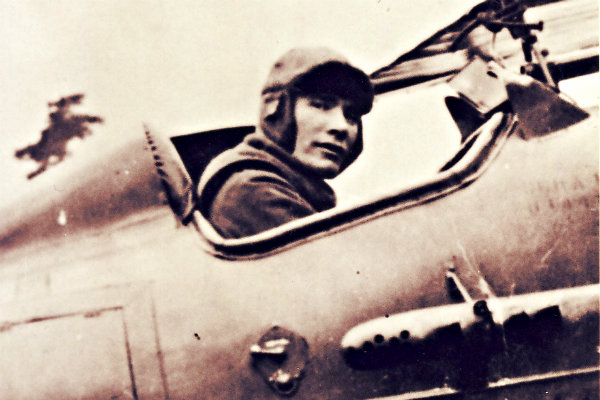Meet Edward Mannock, the British air ace that went on to become the most decorated pilot during the Great War.
When Edward Mannock entered the British armed forces during WWI, he had a poor health and a bad eyesight. To top all of that, he was left shaken by his first encounter with the enemy that fellow pilots thought of him as a coward.
But then, this ‘coward’ went on to become an air ace, garnering ’73’ kills which earned him an echelon of medals under his sleeve, including a Victoria Cross, making him the most decorated British pilot in the whole Great War history.
Knowing the Air Ace
Edward Mannock was born in Brighton in May 24, 1887 to Irish parents with four other siblings. During his childhood years, he developed severe astigmatism in his left eye which damaged his vision. Nevertheless, this handicap did not hinder him from achieving the extraordinary feats he did as a WWI pilot.
Edward Mannock was forced to stop schooling when he was 13 and worked in a series of manual jobs. Eventually, he went on to work for the National Telephone Company with his brother, Patrick. When WWI broke out, he got stranded in Turkey, where he was on assignment laying cables. As Turkey was with the Central Powers, Brits in the country were rounded up and were thrown into a grimy prison.
Suffering inside the prison camp, Edward Mannock passed off time by taunting the prison guards. He would sing British patriotic songs and if he was not doing that, he was in one of his many attempts to escape. Because of his ‘insolence’, he was savagely beaten and thrown into a ghastly cell where body sores festered him. It was during his time there that he contacted dysentery> Both these took a heavy toll on his health.
By the time he was released via the American consulate, Edward Mannock had developed a deep hatred for the Germans and their allies. He was gripped with the obsession of destroying them.
Though declared unfit to serve because of his poor health, Edward Mannock joined the Royal Army Medical Corps’ Territorial Unit. later on, he was commissioned to join the Royal Engineers. When he met, by chance, an old friend, it led him into the Royal Flying Corps, RAF’s forerunner.

The Climb Up
Now an RFC pilot, Edward Mannock was posted in France in April of 1917.
At first, fellow pilots dubbed him as a boorish know-it-all because of his airy attitude. That was further cemented when his first sortie resulted to him being traumatized and shaking in fear.
However, Edward Mannock was able to conquer his fears, gain the confidence he needed and went on to fly with extraordinary skills that impressed even the other pilots. Upon his first skill, his image as a ‘coward’ was wiped out.
According to his biographer, Andy Saunders, Edward Mannock killed Germans with ‘glee’. It may have stemmed from learning that several of his friends had died in their hands or because of the deep resentment he was feeling for being severely treated by the Turks, who were their allies.
Regardless of the reason, one thing was sure. Edward Mannock was a fast German killer. And the mounting numbers of his air ‘kills’ paved way for the many military distinctions he received.
The Troubled Man Behind the Distinguished Air Ace
It was in September 17, 1917 when Edward Mannock won the Military Cross while fending off a number of aircraft all the while downing three of the enemy’s balloons. The next month, he received a bar to the MC after he battled with five enemy war planes, downing one, on his own.
Edward Mannock also went on to receive the Distinguished Service Order thrice in just over a month. He was also promoted to the rank of Major and was given the command of 85 squadron in France.
But behind the brave front of the British air ace, Edward Mannock was a troubled man. he had the lust for German blood, but was haunted by the many lives he took. His personal diary reflected the anguish he was feeling with all the killings he did.
One time, he saw a pilot catch fire while he was falling to the ground and resolved to carry a revolver with him in his aircraft telling a friend that he would kill himself even before the enemy could burn him.
The Mystery of Edward Mannock’s Death
on his last leave, a friend of the air ace recounted how, looking at the face of Edward Mannock, he saw only nervousness given away by his twitching and shaking. His face had lost its old sparkle and along with it, his unrelenting wit.
His last flight occurred in July 26, 1918, just after he made his 73rd kill.
Days before his death, he had warned a comrade about the dangers of flying low. Yet, that unfortunate day, he did that himself. And after making a few low passages above the wrecks, his plane got hit. It was his end.
The Germans, later on, recovered his body and was buried. There is significant evidence that a grave recorded as Unknown Airman in Laventie, France was his. His pilot’s identity discs were sent by a German soldier to his family via the Red Cross. He was also given the Victoria Cross posthumously.

But how Edward Mannock exactly died remained a mystery. His body was reportedly found in perfect condition, suggesting that he might have had made true of his declaration that he would shoot himself before the enemy could burn him down. His body might have been thrown clear away from his plane when it crashed down.
Either way, he got what he wished for — that Edward Mannock would never be burned by the enemy.

